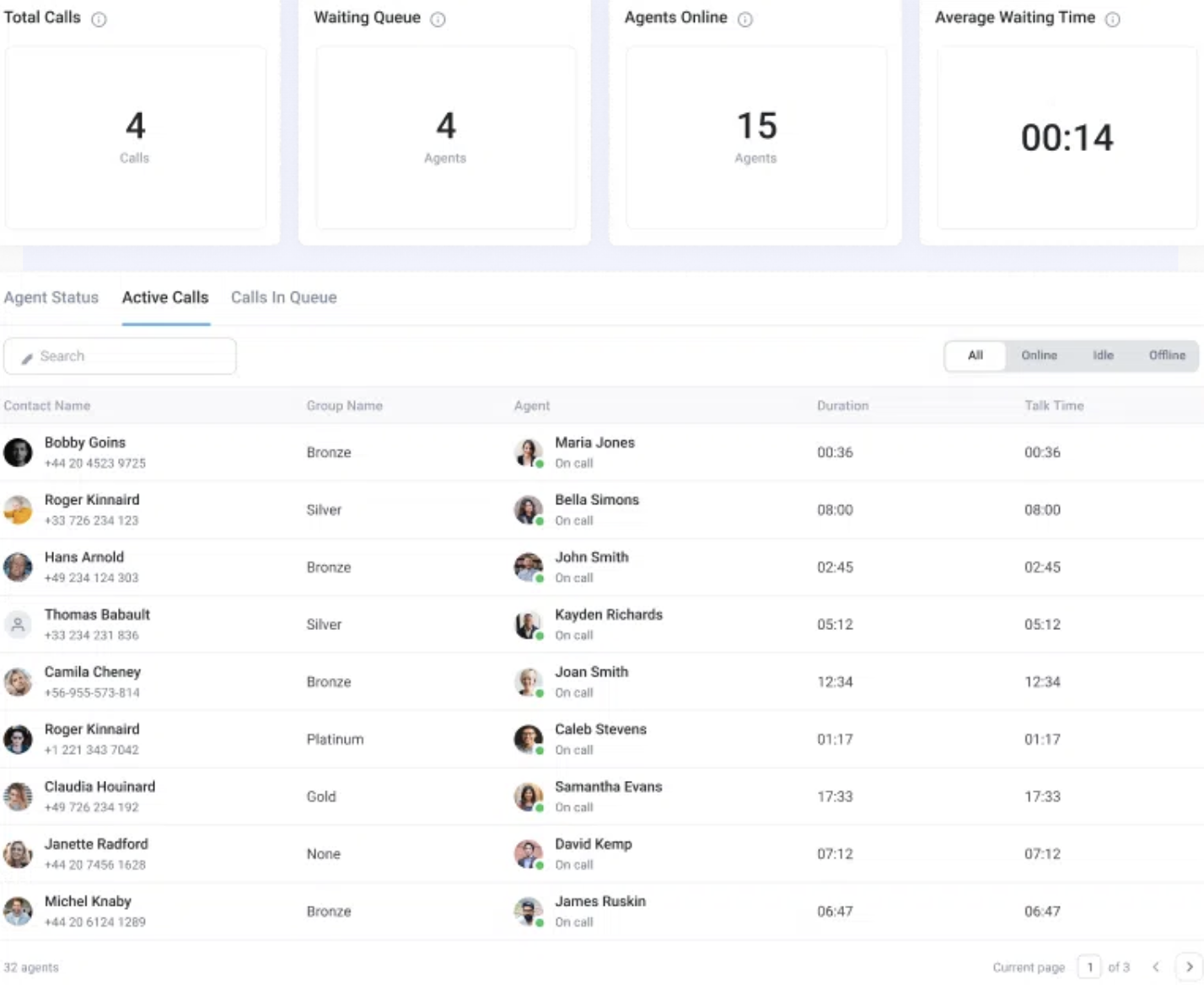8 Best Practices to Optimize the IVR Experience

“Press 1 for sales. Press 2 for support. Press 3 to speak with an agent…”
We’ve all been there—trapped in an endless maze of automated responses while your urgent issue remains unresolved. Your customers share this frustration, with 61% of callers* actively trying to bypass the Interactive Voice Response (IVR) systems to reach a human agent.
But here’s the reality your business faces: Implementing a fully staffed contact center is expensive, and your teams can’t handle every call manually. Hence, IVR remains the most important connection between companies and customers in many sectors.
IVR accounts for twice as many interactions as customer calls with live agents and five times more than text-based chat—and demand for these services is still growing.
If IVR plays such an important role in the customer’s journey, it is time to transform your IVR from a customer pain point into a powerful tool for satisfaction and efficiency. Let’s explore 9 proven practices that leading companies use to create IVR experiences their customers actually appreciate.
Key takeaways:
- A successful IVR system balances automation with human connection—reducing operational costs by 10-30% while maintaining high customer satisfaction.
- CloudTalk’s integrated IVR solutions transform customer interactions through real-time analytics, multi-channel support, and AI-powered features.
- IVR systems directly impact business efficiency and customer loyalty–with some even saving up to $100 million annually.
Optimize the customer IVR experience
How the Interactive Voice Response Experience Impacts Customer Satisfaction
Your customers don’t wake up hoping to navigate an Interactive Voice Response (IVR) system. They call because they need help—and every extra minute spent in a confusing menu makes them feel unheard and ready to hang up.
In fact, 56% of customers say they will stop doing business with a brand after a frustrating experience with support.*
However, your support team is already stretched thin, handling complex issues that require human expertise.
Without an effective IVR system, they waste precious time on routine queries that could be automated. A well-designed IVR doesn’t just reduce workload—it determines whether customers feel supported or stuck in an endless loop. Get it right, and it streamlines service while improving customer trust. Get it wrong, and it becomes a roadblock that drives them away.
So what does an effective IVR system actually offer? Let’s break down the benefits and the challenges that come with it.
Key Benefits of an Optimized IVR System
- Smart automation: IVR can handle routine queries 24/7 without human intervention. By automating common tasks like balance checks and appointment scheduling, businesses typically see a 10-30% reduction in support costs in just 3-6 months while maintaining quality service.
- Enhanced customer experience: A well-designed IVR connects customers to the right solution quickly. With intelligent routing and personalized menus, callers reach their destination in half the time compared to traditional systems, driving higher satisfaction scores.
- Empowered support teams: When basic inquiries are automated, the right agents can focus on complex issues that truly need a human touch. This leads to job satisfaction and better resolution rates for challenging customer needs.
Common IVR Challenges That Present Business Risk
- Poor customer experience design: Many companies design their IVR systems focused solely on cost reduction rather than user experience. Complex menus, confusing terminology, and unclear paths to human agents create frustration and drive customers away from using the system altogether.
- Legacy system limitations: Outdated IVR infrastructure often lacks modern capabilities like Caller Based Routing and CRM integration. This forces customers to navigate rigid, button-based menus and repeat information they’ve already provided through other channels.
- Siloed operations: IVR systems frequently operate disconnected from other business channels and tools. This prevents them from leveraging existing customer data or providing a consistent experience across touchpoints. This results in disjointed customer journeys and missed opportunities for personalization.

8 Best Practices to Improve the Interactive Voice Response Experience
Picture this: It’s 2020, and DiscoverCars’ customer service team is overwhelmed. Their call volume is skyrocketing—30,000 calls per quarter—and waiting times are increasing.
Fast forward to DiscoverCars’ implementation of CloudTalk’s IVR:
- 80% reduction in wait times
- 25% faster call handling
- 15% boost in customer satisfaction.
By 2023, they were handling 100,000 calls per quarter—more than triple their previous volume—with the same team size.
case study
See the full case study to learn how an international car rental website radically transformed its customer service with CloudTalk’s IVR system.
Read the case study
Here are 8 best practices that helped DiscoverCars optimize their IVR experience—and that you can use to enhance yours.
1. Simplify Menu Navigation to Reduce Caller Frustration
Problem: Complex IVR menus create a frustrating maze that drives customers away from finding solutions.
Solution: Streamline navigation by designing user-centric menu structures that prioritize customer needs and minimize decision fatigue.
Implementation strategies:
- Conduct customer calls volume analysis: Map out the most frequent customer inquiries and create direct pathways for these top issues. Eliminate unnecessary menu layers that don’t serve primary customer intents.
- Optimize language and routing: Use clear, conversational menu options that mirror how users actually describe their problems. Ensure each menu option provides a meaningful and distinct route to resolution.
- Provide escape routes: Include a prominent option to speak with a live agent early in the menu. Design your IVR with the understanding that some issues require human intervention, and make that path as smooth as possible.
real-life application
💡In a financial institution based in North America, more than ten million customer requests are fulfilled by IVR (which makes up approx 50 % of the total call volume). This helps the company save around $100 million annually. By redesigning its IVR system using a customer-centric approach, it was able to increase its call-containment rate by a further 2 to 5 percent and improve caller satisfaction by 10 to 25 percent across the call types addressed.
2. Optimize Call Routing for Faster Resolutions
Problem: Traditional routing traps customers in irrelevant support channels. This results in longer resolution times, and lower customer satisfaction.
Solution: Use intelligent routing that connects customers strategically. Match callers with the most appropriate customer support resource. Leverage historical interaction data for precision.
Implementation strategies:
- Map team expertise: Create a skills matrix that captures each customer support team member’s unique capabilities. Document specialized knowledge, language skills, and technical expertise with precision. This detailed mapping allows for more strategic call distribution.
- Integrate customer data: Connect your CRM directly with call routing systems. Pull rich historical interaction data automatically. Prioritize routes based on previous successful interactions, ensuring customers reach the most appropriate resource quickly.
- Implement caller-based routing: Use AI technologies to analyze real-time call context. This could help predict the most effective resolution and reduce unnecessary transfers or customer wait times.
pro tip
💡 Use a condition splitter in your call flow to route calls based on stored contact or call data in CloudTalk. Set logical conditions like country code, tags, industry, or custom attributes to filter incoming calls efficiently.
3. Use AI-Powered Voice Recognition for Smoother Interactions
Problem: Traditional button-based IVR systems force customers to navigate complex menus through keypad entries. This leads to frustration and longer resolution times.
Solution: Implement natural language processing and AI voice recognition to enable conversational interactions. This makes it feel more natural and intuitive for customers.
Implementation strategies:
- Train for accuracy: Build and continuously update voice recognition models using real customer interactions and industry-specific terminology. This helps the IVR system understand accents, dialects, and common phrases or expressions.
- Enable contextual understanding: Configure the system to maintain conversation context and remember previous interactions. This allows for more natural dialogue flow and reduces the need for customers to repeat information.
- Leverage AI Conversation Intelligence: Use CloudTalk’s AI Conversation Intelligence platform to analyze customer interactions, refine voice recognition accuracy, and automate call insights for continuous improvement.
- Design fallback paths: Create clear escalation routes to human agents when the AI system cannot confidently handle a request. This ensures customers never feel trapped in an automated system they can’t escape.
- Monitor and measure: Track key metrics like recognition accuracy, containment rates, and customer satisfaction scores. This is to ensure the voice recognition system genuinely improves the customer experience rather than adding complexity.
4. Personalize IVR Experiences With Customer Data
Problem: Generic IVR interactions make customers feel unrecognized. Plus it forces them to repeat information they’ve already provided across different touchpoints.
Solution: Leverage CRM data and integration capabilities to create personalized IVR experiences. This helps anticipate customer needs and streamline interactions.
Implementation strategies:
- Connect customer data: Integrate your IVR system with your CRM to access customer profiles and interaction history in real-time. This allows for personalized routing based on the caller’s profile.
- Enable smart routing: Use caller history and CRM data to automatically direct customers to the right agent based on their past interactions and current needs.
- Create dynamic menus: Customize IVR menu options based on the customer’s profile, showing relevant choices first and hiding irrelevant ones to reduce menu complexity and save time.
- Implement proactive service: Use customer data to anticipate needs and provide relevant information before the customer asks—for example, offering order status updates for recent purchases.
5. Minimize Wait Times With Smart Call-Back Options
Problem: Long hold times frustrate customers and lead to high call abandonment rates, while also tying up phone lines and system resources.
Solution: Implement an intelligent callback system with CloudTalk, which automatically redials any missed or unanswered calls and evenly distributes them across available agents.
Implementation strategies:
- Set clear callback rules: Create customized protocols for when callbacks are offered, setting parameters for queue length, estimated wait time, and available agent capacity to optimize the customer experience.
- Enable automated queue management: Automatically distribute callbacks across available agents based on skills and capacity. This ensures lower response times and higher satisfaction.
- Maintain conversation context: Tag callbacks with relevant information and history so agents have full context when returning the call, eliminating the need for customers to repeat themselves.
- Customize callback windows: Allow customers to schedule callbacks during their preferred time slots while matching these to your staffing patterns and peak service hours.
pro tip
💡Pro tip: Communicate realistic timelines to your customers so they know when to expect your call. This will reduce repeat calls and minimize frustration.
6. Provide Multi-Channel Support for Seamless Transitions
Problem: Customers get frustrated when limited to a single communication channel, especially when different situations call for different types of interaction.
Solution: Implement an integrated multi-channel system that combines voice, click-to-call, voicemail, and automated messaging capabilities to provide flexible communication options.
Implementation strategies:
- Enable click-to-call functionality: Transform phone numbers across your web presence into clickable links using click-to-call technology. This allows customers to instantly initiate calls from your website, CRM, or help desk platforms without manual dialing.
- Implement smart voicemail drops: Use voicemail drop capabilities to leave pre-recorded messages when customers are unavailable. This ensures consistent messaging while saving agent time and maintaining personalization.
- Set up automated callbacks: Rather than keeping customers waiting on hold, offer automated callback options. This respects their time while ensuring they receive the help they need.
- Integrate business hours management: Configure your system to automatically route calls to appropriate channels based on business hours—directing to voicemail after hours or to alternative customer support teams during peak periods.
7. Continuously Monitor and Improve IVR Performance
Problem: Without proper monitoring and analytics, IVR systems can become outdated and ineffective. This could lead to declining customer satisfaction and missed optimization opportunities.
Solution: Implement comprehensive analytics tools to track key performance metrics. Also, continuously optimize your IVR system based on real data and customer behavior patterns.
Implementation strategies:
- Track essential metrics: Monitor crucial IVR performance indicators using CloudTalk’s Real-Time Dashboard and Analytics features. Key metrics include, but are not limited to total calls, average talk time, call abandonment rates, and customer satisfaction scores.
- Enable real-time monitoring: Use CloudTalk’s Wallboard functionality to display live performance metrics to your entire team. This helps managers quickly identify and address issues as they arise, rather than discovering problems after the fact.
- Analyze agent performance: Leverage agent reporting capabilities to track individual and team performance metrics. This data helps identify top performers, spot training opportunities, and optimize resource allocation.
Review group performance: Give managers comprehensive visibility into their team’s metrics through group reporting features. This broader view helps identify systemic issues and opportunities for process improvements.

8. Design IVR for Accessibility and Inclusivity
Problem: Traditional IVR systems can be inaccessible to users with disabilities and those who speak different languages. This could misalign with a core element of your brand while potentially excluding segments of your customer base.
Solution: Design an inclusive IVR experience that leverages CloudTalk’s text-to-speech technology and accessibility features to serve all users effectively, regardless of their language or accessibility needs.
Implementation strategies:
- Enable multilingual support: Utilize CloudTalk’s text-to-speech capabilities to provide IVR prompts in multiple languages. This allows callers to select their preferred language at the start of their call and maintain consistent, natural-sounding voices across all language options.
- Prioritize accessibility features: Implement adjustable speech rate and pitch settings to improve comprehension for users with hearing impairments. These features help ensure all users can navigate your IVR customer service system effectively.
Implement amazing IVR experiences and reduce customer service costs by up to 30%
IVR has evolved from basic call routing to a key driver of customer experience and cost efficiency. Companies see 10-30% cost reductions in just a few months, with major financial institutions saving up to $100 million annually.
With CloudTalk’s integrated solutions, IVR isn’t just about cutting costs—it streamlines operations, improves customer satisfaction, and ensures every caller gets the help they need, fast.
But success depends on thoughtful implementation. A poorly designed IVR frustrates customers and increases call abandonment, while an optimized system enhances self-service, reduces agent workload, and personalizes interactions.
CloudTalk makes this possible by balancing automation with human support, using AI-driven insights, smart routing, and real-time speech analytics to continuously refine the experience.
Optimize the customer IVR experience
Sources:
FAQs About IVR Experiences
How Can IVR Improve First-Call Resolution Rates?
Strategic IVR design leverages caller history, implements intelligent routing, and provides self-service options that resolve issues without agent intervention.
What Metrics Should Businesses Track to Measure IVR Performance?
Critical IVR KPIs include abandonment rate, average handle time, and self-service completion rate, to optimize customer interaction.
How Do You Balance Automation and Human Support in IVR?
Create a hybrid support approach that automates simple tasks while enabling quick escalation to human agents.
What Are the Most Common IVR Mistakes That Frustrate Callers?
Typical IVR frustrations include complex menus, limited navigation options, no human agent access, long wait times, and poor speech recognition.
How Often Should IVR Systems Be Updated or Optimized?
To keep your IVR systems updated, conduct monthly and quarterly audits. Also, use a Real-Time Dashboard and customer feedback to keep the system efficient and user-friendly.





















